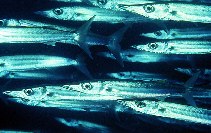| Family: |
Sphyraenidae (Barracudas) |
| Max. size: |
92.3 cm FL (male/unsexed); max.weight: 4,085.0 g |
| Environment: |
reef-associated; marine; depth range 6 - 300 m |
| Distribution: |
Indo-Pacific: East Africa to Southeast Asia and the Marquesan and Society islands, north to southern Japan, south to New Caledonia. |
| Diagnosis: |
Dorsal spines (total): 6-6; Dorsal soft rays (total): 9-9; Anal spines: 2-2; Anal soft rays: 9-9. Body elongate and sub cylindrical with small cycloid scales; head long and pointed. Mouth large and horizontal, the tip of the lower jaw protruding; intermaxilla non-protractile. Preoperculum broadly rounded. Lower limb of the first fill arch with spiny tubercles. First dorsal fin origin opposite or before the pectoral tip, the first spine shorter than the second. Color is generally blackish above and silvery below.
Description: Characterized further by having 112-123 lateral line scales; absence of gill rakers, spinules on 10-20 tubercles of lower limb; closely spaced teeth, posterior ones in lower jaw angeled backwards; very large eye; depth of body 6.9-7.7 in SL (Ref. 90102). |
| Biology: |
Nocturnally active, but occurring in large schools above lagoon patch reefs and along outer reef slopes during the day (Ref. 9768, 48637). Feeds mainly on fishes, but also on penaeid shrimps and squids. Sold fresh, frozen or dried salted. Reports of ciguatera poisoning need confirmation. |
| IUCN Red List Status: |
Least Concern (LC); Date assessed: 14 August 2023 Ref. (130435)
|
| Threat to humans: |
reports of ciguatera poisoning |
Source and more info: www.fishbase.org. For personal, classroom, and other internal use only. Not for publication.
